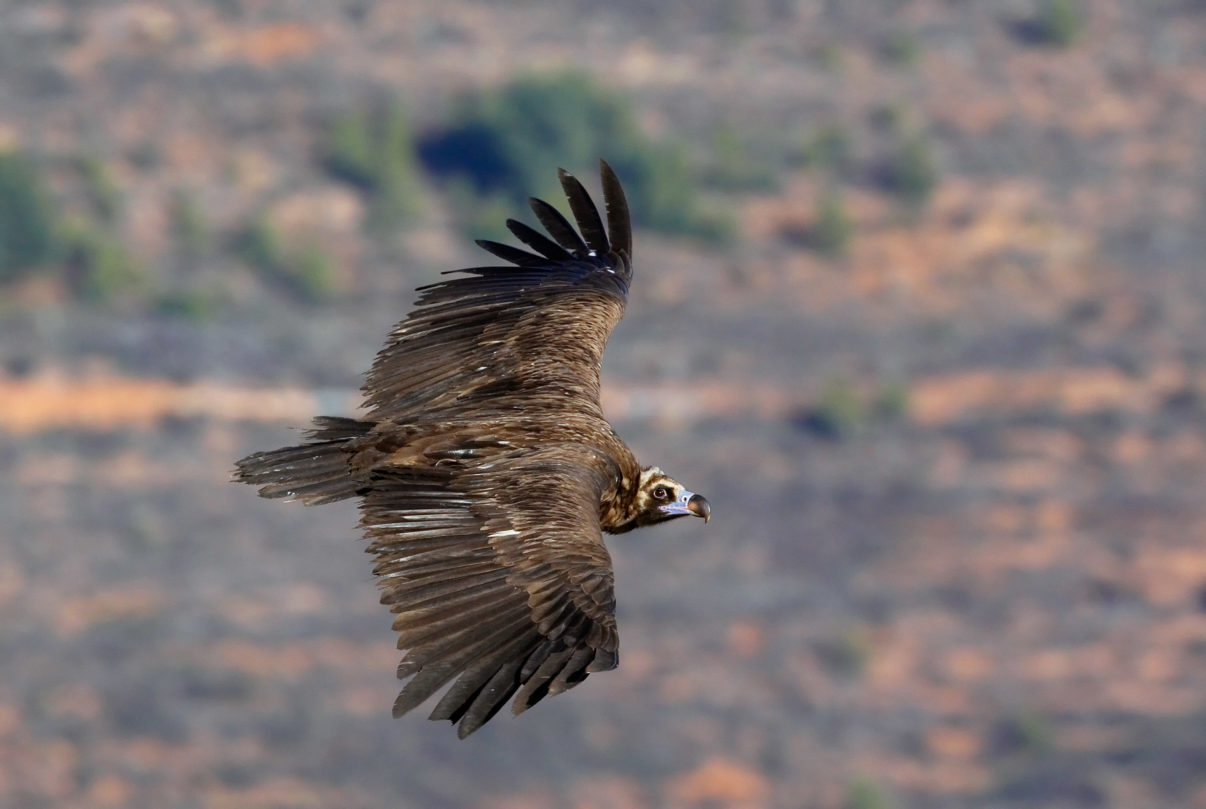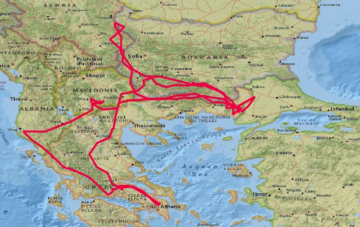Chrysoula, a juvenile black vulture fitted with a GPS transmitter, recently made a 3200-kilometre, 17-day journey over the Balkans. Her incredible aerial circuit gives the Rhodope Mountains rewilding team new insight into vulture behaviour and will help ongoing vulture conservation efforts in the area.

Balkan odyssey
A juvenile black (cinereous) vulture, tagged in the Dadia-Lefkimi-Soufli Forest National Park in northern Greece in 2017 as part of the ongoing LIFE Vultures project, recently undertook an astonishing 3200-kilometre, 17-day aerial adventure across the Balkans. This was the first journey that “Chrysoula” (meaning “golden” in Greek) had made outside the Rhodope Mountains.

Starting in Dadia on the morning of March 17, Chrysoula flew north to Serbia before returning to her native colony. She then flew over northern Macedonia, spending a day in Albania – the first record of this species in the country for decades. The intrepid traveller then headed south, reaching Athens in three days.
She spent a night in the outskirts of the city, before deciding to finally head home. Following the topography of the Rhodope Mountains, she arrived back in Dadia on the afternoon of April 4, almost immediately visiting the local supplementary feeding station to refuel with her friends.
Wonderful wanderings
Black vultures are renowned for their majestic aerial prowess, as they soar through the sky on uplifting thermals. What they are far less well-known for is their nomadic behaviour – adult black vultures are generally thought to be sedentary birds, rarely straying far from their home territory.
The GPS tagging and tracking currently being carried out by the Rewilding Rhodopes team is demonstrating that some juvenile black vultures are affected by wanderlust, however. It is thought that the tendency of these birds to travel outside their home range and explore new areas is connected with a desire to locate other vulture colonies, and to find new areas with good feeding opportunities.
The Rewilding Rhodopes team has witnessed other amazing aerial voyages over the last few years. Last year a tagged juvenile black vulture called Helena travelled nearly 2200 kilometres in 11 days, flying directly over both the Southern Carpathians rewilding area in Romania and the Rhodope Mountains rewilding area in Bulgaria.
Another fantastic flight was completed by Lefteris, who travelled around 1100 kilometres in 11 days, exploring Bulgaria’s Central Balkan National Park before returning to Dadia.
Breeding colony
The Dadia-Lefkimi-Soufli Forest National Park is the last stronghold of the black vulture in the Balkans. Today the Eastern Rhodope Mountains of Greece hosts the only breeding colony of the species on the peninsula, with around 30-35 pairs breeding annually. The number of breeding pairs has remained relatively stable in recent years.
The black vulture is now considered extinct as a breeding species across the border from Dadia in Bulgaria, but LIFE Vultures project work includes efforts to encourage the birds to begin nesting again in the country. The journeys made by Chrysoula and other vultures offers hope that this may happen one day in the near future. They also demonstrate that vultures know no borders, and that effective vulture conservation depends on the coordinated action of all countries across the region.
Insightful impact
Starting in 2016, the five-year LIFE Vultures project was developed by Rewilding Europe, in collaboration with the Rewilding Rhodopes Foundation and a range of other partners. Focusing on the Rhodope Mountains rewilding area in Bulgaria, as well as a section of the Rhodope Mountains in northern Greece, the aim of the project is to support the recovery and further expansion of the black and griffon vulture populations in this part of the Balkans, mainly by improving natural prey availability, and by reducing mortality through factors such as poaching, poisoning and collisions with power lines.
The tagging being carried as part of the LIFE Vultures project – the first of its kind in the Rhodope Mountains for griffon vultures, and the biggest for black vultures in the whole of the Balkans – is essential to maximising its success. As GPS data is systematically fed into a Geographic Information System (GIS), together with a range of other variables, so the rewilding team and their partners are gaining groundbreaking insight into the movement of vulture populations in the monitoring area, the various threats that they face, and the best ways to support the birds’comeback.
The recently launched Rewilding Rhodopeswebsite features a live vulture tracker showing the (almost) real time routes of tagged birds.
Want to know more?
- Visit the Rewilding Rhodopes Foundation website
- Read about the LIFE Vultures project
- Read about the Rhodope Mountains rewilding area
- Visit the Rewilding Rhodopes Facebook page
